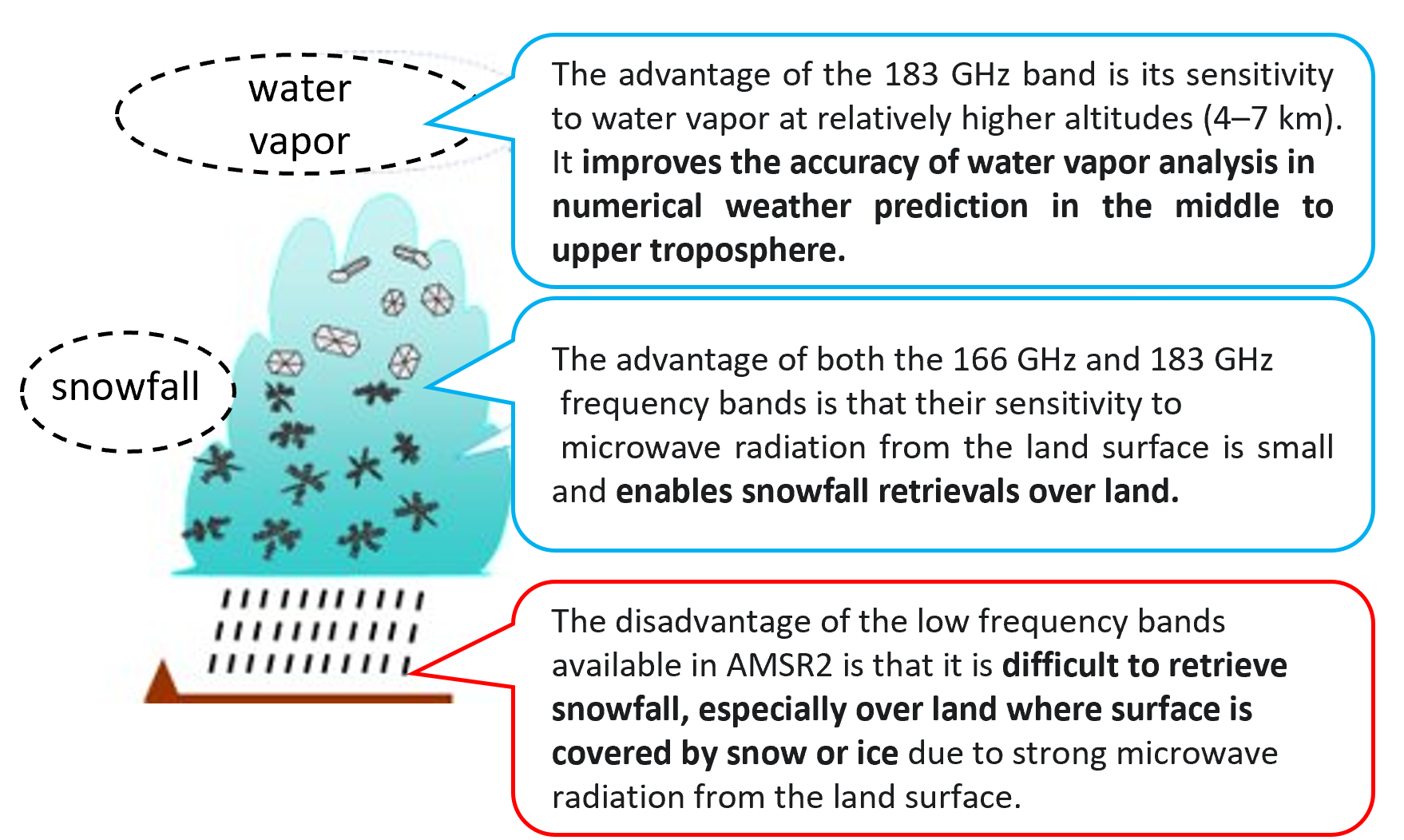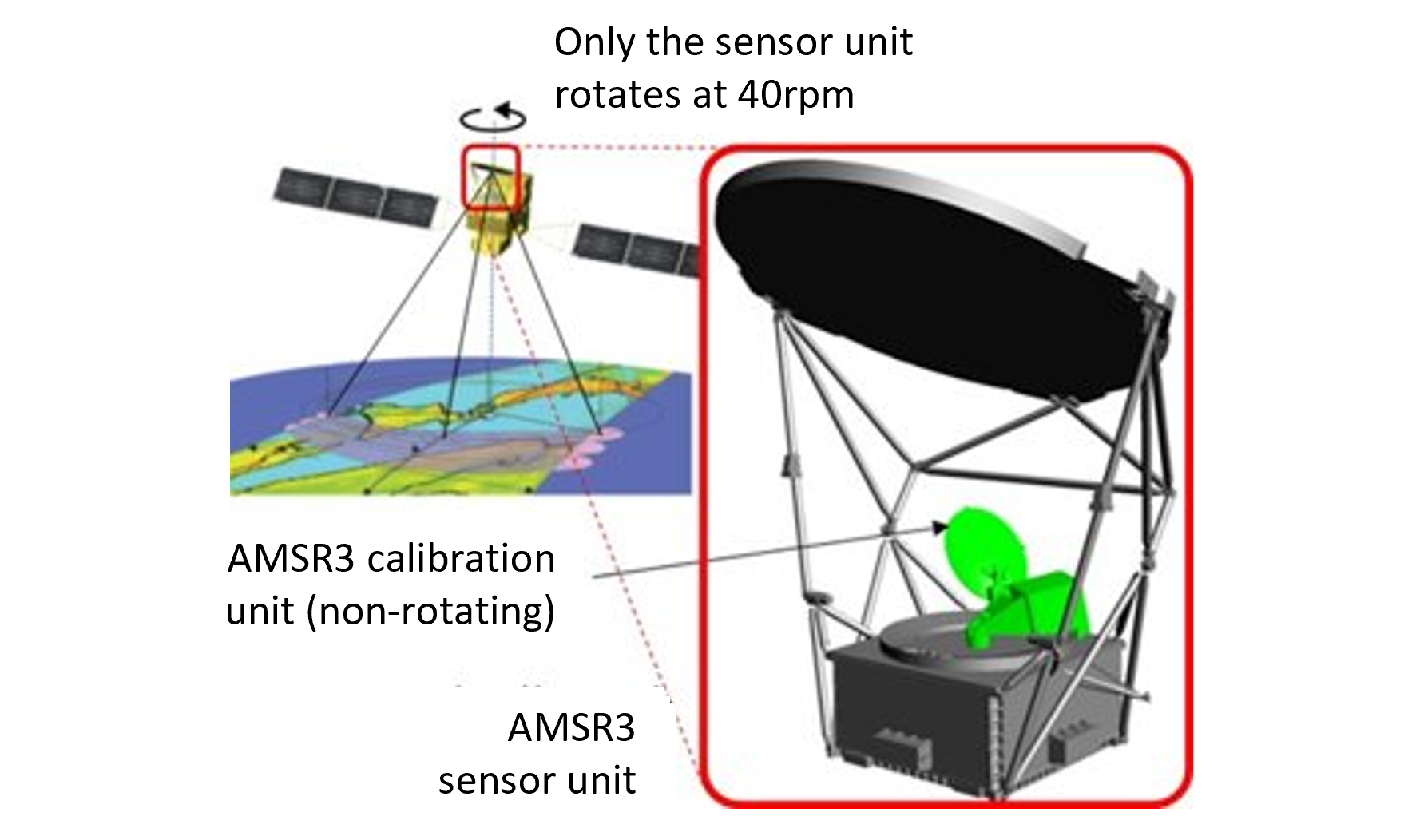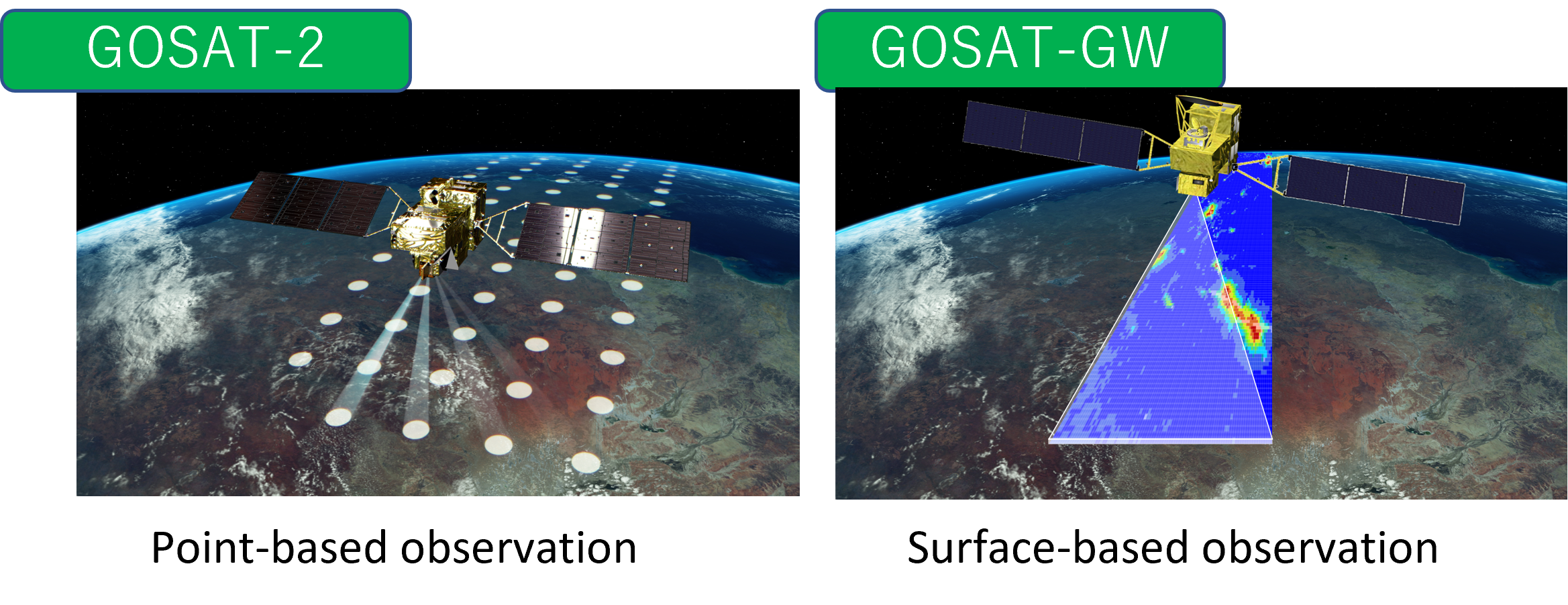- HOME >
- Satellite Projects >
- IBUKI GW (GOSAT-GW)

Mission
In recent years, disasters caused by extreme weather have become more severe, and understanding climate change, which is believed to be the cause, is essential to predict the impact on society and develop countermeasures. To contribute to this effort, JAXA has been developing the Global Observing SATellite for Greenhouse gases and Water cycle (GOSAT-GW*1).
GOSAT-GW will be equipped with two sensors, TANSO-3 for observing greenhouse gases, and AMSR3 for observing physical quantities related to water such as sea surface temperature.
The mission of GOSAT-GW is a developmental continuation of the water cycle variation observation mission of "SHIZUKU" (GCOM-W*2), which was launched in 2012, and the greenhouse gases observation missions of "IBUKI" (GOSAT*3), which was launched in 2009, and "IBUKI-2" (GOSAT-2*3), which was launched in 2018.
Two successors, the Advanced Microwave Scanning Radiometer 3 (AMSR3), and the Total Anthropogenic and Natural emissions mapping SpectrOmeter-3 (TANSO-3), which is being developed by JAXA under a contract with the Ministry of the Environment, will be mounted on GOSAT-GW.
Mitsubishi Electric Corporation is primarily responsible for the development of the satellite and its onboard sensors.
※1 The Global Observing SATellite for Greenhouse gases and Water cycle
※2 The Global Change Observation Mission – Water
※3 The Greenhouse gases Observing SATellites
GOSAT-GW and its onboard sensors

①AMSR3
(Advanced Microwave Scanning Radiometer 3)
The Advanced Microwave Scanning Radiometer 3 (AMSR3) observes weak microwaves naturally emitted from the land and ocean surfaces and in the atmosphere.
Number of frequency bands of AMSR3 is increased compared to that of AMSR2 to enable observations of snowfall and water vapor in the upper atmosphere.
②TANSO-3
(Total Anthropogenic and Natural emissions mapping SpectrOmeter-3)
The Total Anthropogenic and Natural emissions mapping SpectrOmeter-3 (TANSO-3) sensor, developed by JAXA under contract with the Ministry of the Environment, is the successor to the TANSO-FTS-2※4 on IBUKI-2. TANSO-3 uses grating imaging spectrometer, replacing the Fourier transform spectroscopy used in TANSO-FTS-2. TANSO-3 enables spatially detailed observation of greenhouse gases, including carbon dioxide (CO2) and methane (CH4). With TANSO-3, we will also newly observe nitrogen dioxide (NO2). Nitrogen dioxide (NO2) observation is added as well.
※4 TANSO-FTS-2: Thermal And Near infrared Sensor for carbon Observation - Fourier Transform Spectrometer-2
GOSAT-GW Technologies
POINT 1: AMSR3 will provide further continuous observation of water-related information for more than 20 years and will have new observation channels.
POINT 2: TANSO-3 will provide wide-area, high-precision observation of greenhouse gases.
AMSR3 will provide further continuous observation of water-related information and will have new observation channels.
The Advanced Microwave Scanning Radiometer (AMSR) series has contributed to a variety of fields for 20 years. Observations include sea surface temperature, ocean wind speed, soil moisture, snow depth, and sea ice concentration, and these data are being used in a wide range of fields, including weather forecasting, fisheries, navigational support, and understanding climate change.
For example, observation data can be used to improve the accuracy of precipitation predictions in weather forecasts, improve typhoon path predictions, and in the fisheries industry by utilizing the relationship between sea surface temperature and fishing grounds.
▸ Click here for examples of AMSR series applications
The Advanced Microwave Scanning Radiometer 3 (AMSR3) on board GOSAT-GW is the successor to the AMSR2 on board "SHIZUKU" and aims to achieve the world's top performance and functionality as a microwave radiometer.
The Microwave radiometer measures weak microwaves emitted from the Earth’s surface and the atmosphere, allowing us to observe physical quantities related to water on the Earth's surface and sea surface, and inside clouds by its cloud penetrating capability.
Since nighttime observations are also possible, it has the unique ability to perform observations at any time, regardless of weather or time of day.
The AMSR3 will be equipped with the additional 166 and 183 GHz frequency bands compared to the AMSR2.
This will provide new observation products such as precipitation and snowfall, as well as more spatially detailed observation of existing observation products, with the aim of improving the accuracy of water vapor analysis in numerical forecasts and enabling snowfall observations.


The AMSR series data can be viewed at the following URLs:
TANSO-3 will provide wide-area, high-precision observation of greenhouse gases.
The main feature of TANSO-3 is that it will adopt the diffraction grating type spectroscopy method instead of the Fourier transform spectroscopy method used in the greenhouse gases observation sensors TANSO-FTS and TANSO-FTS-2 aboard GOSAT and GOSAT-2.
With this method, it is now possible to observe over a whole area, rather than the grid-like observations that were previously performed, making it possible to obtain much more observational data.
TANSO-3 also has two observation modes: wide-area observation mode and focus observation mode,
- ・In Wide mode, TANSO-3 observes an area with a spatial resolution of 10 km over a swath at least 911 km wide.
- ・In Focus mode, TANSO-3 can carry out the detailed observation with a spatial resolution of 3 km over a swath at least 90 km wide.

GOSAT-GW will observe nitrogen dioxide (NO2) in addition to carbon dioxide (CO2) and methane (CH4). NO2 is discharged together with CO2 during the burning of fossil fuels, and thus it is expected that simultaneously measuring NO2 will make it possible to identify human-induced CO2 emission sources and accurately estimate emissions.
▸ For information on using GOSAT and GOSAT-2 data, click here.
▸ GOSAT and GOSAT-2 data can be viewed and downloaded here.
- ・GOSAT Data Archive Service (National Institute for Environmental Studies)
- ・GOSAT-2 Product Archive (National Institute for Environmental Studies)
▸ GOSAT series introduction video (Produced by: Ministry of the Environment) [Japanese]
This video introduces the observation results of GOSAT and GOSAT-2, and expectations for GOSAT-GW.

Specifications
Specifications and Launch Date of GOSAT-GW
Satellite name
GOSAT-GW (IBUKI GW)
<Reference satellite>
GOSAT-2 (IBUKI-2)
GCOM-W (SHIZUKU)
Mission instruments
Advanced Microwave Scanning Radiometer 3
(AMSR3)
Total Anthropogenic and Natural emissions mapping SpectrOmeter-3
(TANSO-3)
Thermal And Near infrared Sensor for carbon Observation - Fourier Transform Spectrometer-2
(TANSO-FTS-2)
Thermal And Near infrared Sensor for carbon Observation - Cloud and Aerosol Imager-2
(TANSO-CAI-2)
Advanced Microwave Scanning Radiometer 2
(AMSR2)
Spacecraft launch Mass
Approximately 2.6 t
1.8 t
Approximately 2 t
Power generation (EOL)
Approximately 5,300 W
5,000 W
3,880 W or more
Designed lifetime
7 years or more
5 years
5 years
Orbit type
Synchronous sub-recurrent orbit
Synchronous sub-recurrent orbit
Synchronous sub-recurrent orbit
Altitude
666 km(Same as GOSAT (IBUKI))
613 km
699.6 km
Recurrent period
3 days
6 days
16 days
Local Sun Time
Ascending node:
13:30±15 minutes
(Same as GCOM-W (SHIZUKU))
Descending node:
13:00±15 minutes
Ascending node:
13:30±15 minutes
Launch date
JFY 2024 (planned)
October 29, 2018
May 18, 2012
Related Sites
AMSR3 will provide further continuous observation of water-related information and will have new observation channels.
The Advanced Microwave Scanning Radiometer (AMSR) series has contributed to a variety of fields for 20 years. Observations include sea surface temperature, ocean wind speed, soil moisture, snow depth, and sea ice concentration, and these data are being used in a wide range of fields, including weather forecasting, fisheries, navigational support, and understanding climate change.
For example, observation data can be used to improve the accuracy of precipitation predictions in weather forecasts, improve typhoon path predictions, and in the fisheries industry by utilizing the relationship between sea surface temperature and fishing grounds.
▸ Click here for examples of AMSR series applications
The Advanced Microwave Scanning Radiometer 3 (AMSR3) on board GOSAT-GW is the successor to the AMSR2 on board "SHIZUKU" and aims to achieve the world's top performance and functionality as a microwave radiometer.
The Microwave radiometer measures weak microwaves emitted from the Earth’s surface and the atmosphere, allowing us to observe physical quantities related to water on the Earth's surface and sea surface, and inside clouds by its cloud penetrating capability.
Since nighttime observations are also possible, it has the unique ability to perform observations at any time, regardless of weather or time of day.
The AMSR3 will be equipped with the additional 166 and 183 GHz frequency bands compared to the AMSR2.
This will provide new observation products such as precipitation and snowfall, as well as more spatially detailed observation of existing observation products, with the aim of improving the accuracy of water vapor analysis in numerical forecasts and enabling snowfall observations.


The AMSR series data can be viewed at the following URLs:
TANSO-3 will provide wide-area, high-precision observation of greenhouse gases.
The main feature of TANSO-3 is that it will adopt the diffraction grating type spectroscopy method instead of the Fourier transform spectroscopy method used in the greenhouse gases observation sensors TANSO-FTS and TANSO-FTS-2 aboard GOSAT and GOSAT-2.
With this method, it is now possible to observe over a whole area, rather than the grid-like observations that were previously performed, making it possible to obtain much more observational data.
TANSO-3 also has two observation modes: wide-area observation mode and focus observation mode,
- ・In Wide mode, TANSO-3 observes an area with a spatial resolution of 10 km over a swath at least 911 km wide.
- ・In Focus mode, TANSO-3 can carry out the detailed observation with a spatial resolution of 3 km over a swath at least 90 km wide.

GOSAT-GW will observe nitrogen dioxide (NO2) in addition to carbon dioxide (CO2) and methane (CH4). NO2 is discharged together with CO2 during the burning of fossil fuels, and thus it is expected that simultaneously measuring NO2 will make it possible to identify human-induced CO2 emission sources and accurately estimate emissions.
▸ For information on using GOSAT and GOSAT-2 data, click here.
▸ GOSAT and GOSAT-2 data can be viewed and downloaded here.
- ・GOSAT Data Archive Service (National Institute for Environmental Studies)
- ・GOSAT-2 Product Archive (National Institute for Environmental Studies)
▸ GOSAT series introduction video (Produced by: Ministry of the Environment) [Japanese]
This video introduces the observation results of GOSAT and GOSAT-2, and expectations for GOSAT-GW.

Specifications
Specifications and Launch Date of GOSAT-GW
| Satellite name | GOSAT-GW (IBUKI GW) | <Reference satellite> | |
| GOSAT-2 (IBUKI-2) | GCOM-W (SHIZUKU) | ||
| Mission instruments |
Advanced Microwave Scanning Radiometer 3 (AMSR3) Total Anthropogenic and Natural emissions mapping SpectrOmeter-3 (TANSO-3) |
Thermal And Near infrared Sensor for carbon Observation - Fourier Transform Spectrometer-2 (TANSO-FTS-2) Thermal And Near infrared Sensor for carbon Observation - Cloud and Aerosol Imager-2 (TANSO-CAI-2) |
Advanced Microwave Scanning Radiometer 2 (AMSR2) |
| Spacecraft launch Mass | Approximately 2.6 t | 1.8 t | Approximately 2 t |
| Power generation (EOL) | Approximately 5,300 W | 5,000 W | 3,880 W or more |
| Designed lifetime | 7 years or more | 5 years | 5 years |
| Orbit type | Synchronous sub-recurrent orbit | Synchronous sub-recurrent orbit | Synchronous sub-recurrent orbit |
| Altitude | 666 km(Same as GOSAT (IBUKI)) | 613 km | 699.6 km |
| Recurrent period | 3 days | 6 days | 16 days |
| Local Sun Time |
Ascending node: 13:30±15 minutes (Same as GCOM-W (SHIZUKU)) |
Descending node: 13:00±15 minutes |
Ascending node: 13:30±15 minutes |
| Launch date | JFY 2024 (planned) | October 29, 2018 | May 18, 2012 |
